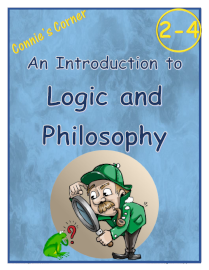An Introduction to Logic and Philosophy is a 131-page book (PDF) that introduces children in grades two through four to logic and philosophy, as well as to some key historical figures in those fields. It manages to do this by using brief instructional information accompanied by worksheet activities. Ninety pages provide the information, activities, and periodic reviews. You will probably complete one page per session with a child. Additional activities in the “Going Beyond” appendix are optional. By completing about two pages per week, you can complete the course in one school year.
Since logic and philosophy are generally unfamiliar to young students, the course teaches some vocabulary words such as philosophy, logic, ethics, metaphysics, and epistemology. These words and their meanings are discussed frequently throughout the course since it might take a while for children to grasp their meanings. Activities such as matching words with their definitions, composing a sentence that uses a vocabulary word, and finding vocabulary words in word search puzzles help.
Even more helpful are the “Case Studies” that present a situation then ask a question that requires students to apply what they have learned. For instance, one case study begins, “Alice wanted to know how fast a horse can run. She decides to measure her neighbor’s horse.” It continues by explaining how she times the horse’s running speed. The question that follows asks students whether Alice used science or philosophy to figure this out. The frequent case studies are used throughout the book to help students understand other concepts as well.
Students are introduced to logic by first looking at relationships between items to identify similarities and differences. Then lessons about analogies extend their understanding of categories. Lessons continue with instruction on other basic concepts, such as distinguishing between facts and opinions and between causes and effects.
A variety of other activities are used to reinforce lessons—activities such as completing analogies, syllogisms, and sentences; solving crossword and logic-grid puzzles; and working with riddles, codes, and Venn diagrams.
“History Spotlights” feature brief biographies of eight key philosophers: Thales, Socrates, Aristotle, Augustine of Hippo, Aquinas, Machiavelli, Descartes, and Kant. These are each followed by multiple-choice questions that check for reading comprehension.
In addition to periodic reviews, there is a final, two-page quiz. Answer keys for activities, reviews, and the quiz are at the end of the book.
Discussion notes at the back of the book have more information on some of the topics and the philosophers, along with some teaching suggestions. The lessons themselves are self-explanatory, so you can use the discussion notes or not as you please.
The Going Beyond appendix has entirely different activities. Some activities are great for grades two through four, and some are beyond that level. There are art and other hands-on activities, such as:
- sculpting an image of a friend’s head from clay
- finding facts and opinions in printed material, then cutting and pasting them on to a page
- cutting and pasting images of the eight philosophers on a timeline (images and timeline provided in the appendix)
- learning to draw faces with proper proportions
- viewing paper surfaces through a microscope
Among the other activities are map work, story plot mapping, a Venn-diagram comparison of three philosophers, a guided research paper on a philosopher, and learning about the concept of infinity (e.g., by dividing a circle with as many diameter lines as possible and dividing irrational numbers like pi). Obviously, some of these would be best for students who are older than this book's target audience, so it's difficult to see how they fit in.
You will need to print out almost the entire book since just about every page has a student activity. Some pages have pictures of colored objects with questions that relate to colors, so those will need to be printed in color.
This course does not promote religious belief. However, it includes two pages that are labeled optional and discuss philosophical arguments for theism and atheism and a third page that mentions the Declaration of Independence’s references to God. These lessons are presented in a balanced fashion, and they are included since it is impossible to talk about philosophy without ever mentioning belief or non-belief in God, gods, and other metaphysical concepts.
While there are many introductory books about logic for young students, there are hardly any that present philosophy at this level. The vocabulary and ideas might be challenging, but An Introduction to Logic and Philosophy seems like a great starting place for teaching children about logic and philosophy together.








